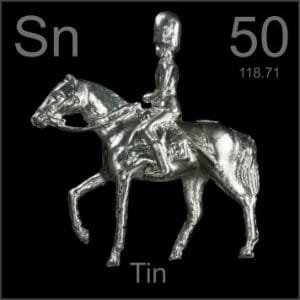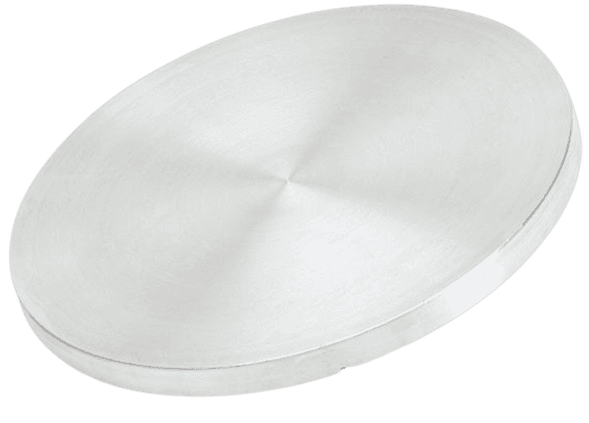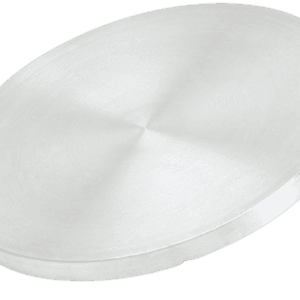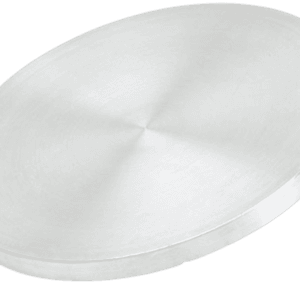ST0497 Indium Tin Sputtering Target, In/Sn
Chemical Formula: In/Sn
Catalog Number: ST0497
Purity: 99.99%
Shape: Discs, Plates, Column Targets, Step Targets, Custom-made
Indium Tin sputtering target come in various forms, purities, sizes, and prices. Thin Film Materials (TFM) manufactures and supplies top-quality sputtering targets at competitive prices.
Indium Tin Sputtering Target Description
 Indium is a chemical element derived from the Latin word ‘indicium,’ which refers to the violet or indigo color seen in its spectral lines. It was first discovered in 1863 by F. Reich and T. Richter, with its isolation confirmed and announced by T. Richter. The symbol for indium is “In,” and it is positioned in Period 5, Group 13 of the periodic table, within the p-block. Its atomic number is 49, and its relative atomic mass is 114.818(3) Dalton, with the number in brackets reflecting the associated uncertainty.
Indium is a chemical element derived from the Latin word ‘indicium,’ which refers to the violet or indigo color seen in its spectral lines. It was first discovered in 1863 by F. Reich and T. Richter, with its isolation confirmed and announced by T. Richter. The symbol for indium is “In,” and it is positioned in Period 5, Group 13 of the periodic table, within the p-block. Its atomic number is 49, and its relative atomic mass is 114.818(3) Dalton, with the number in brackets reflecting the associated uncertainty.

Tin, known as *stannum* in Latin, comes from the Anglo-Saxon word “tin,” which means “hard.” This element has been utilized since around 3500 BC. Represented by the symbol “Sn,” tin is located in Period 5, Group 14 of the periodic table, within the p-block. It has an atomic number of 50 and a relative atomic mass of 118.710(7) Dalton, with the number in brackets indicating the associated uncertainty.
Related Products: Indium Sputtering Target, Tin Sputtering Target.
Indium Tin Sputtering Target Specifications
| Material Type | Indium Tin |
| Symbol | In/Sn |
| Color/Appearance | Metallic solid in various forms including powder, sputtering target, foil, bar, plate |
| Melting Point | 117 °C |
| Density | / |
| Available Sizes | Dia.: 2.0″, 3.0″, 4.0″, 5.0″, 6.0″ Thick: 0.125″, 0.250″ |
We also offer other customized shapes and sizes of the sputtering targets; please Contact Us for more information.
Indium Tin Sputtering Target Application
The Indium Tin Sputtering Target is utilized in various applications, including thin film deposition, decorative coatings, and in the production of semiconductors. It is particularly effective for use in displays, LEDs, and photovoltaic devices. Additionally, it serves in functional coatings and is valuable for optical information storage, glass coatings for both automotive and architectural purposes, and optical communication technologies.
Packing
Our Indium Tin Sputtering Targets are meticulously tagged and labeled to facilitate easy identification and ensure rigorous quality control. We take extensive measures to prevent any potential damage during both storage and transportation, ensuring the targets arrive in pristine condition.
Related Products
Related products
FAQ
What is a sputtering target?
It’s the source material (in solid form) used in sputter deposition to eject atoms or molecules that then form a thin film on a substrate.
What materials are used to make sputtering targets?
Targets can be pure metals (e.g., gold, copper, aluminum), ceramics (e.g., Al₂O₃, SiO₂, TiO₂), alloys, or composites—chosen based on the film’s desired properties.
How are sputtering targets manufactured?
They are produced by processes such as melting/casting for metals or sintering (often with hot isostatic pressing) for ceramics and composite targets to ensure high density and purity.
How does sputter deposition work with these targets?
In a vacuum chamber, a plasma (typically argon) bombards the target, ejecting atoms that travel and condense on a substrate, forming a thin film.
What factors affect the life and performance of a sputtering target?
Key factors include the target’s purity, density, grain structure, and the sputtering yield (i.e. how many atoms are ejected per incident ion), as well as operating conditions like power density and gas pressure.
How do I know when a sputtering target needs to be replaced?
Operators monitor target erosion (often by measuring the depth of the eroded “race track”) or track total energy delivered (kilowatt-hours) until it reaches a threshold that can compromise film quality.
Why do some sputtering targets need to be bonded to backing plates?
Fragile materials (such as many ceramics or certain oxides) and precious metals often require a backing plate to improve cooling, mechanical stability, and to allow thinner targets that reduce material costs.
What is the difference between DC and RF sputtering for targets?
DC sputtering is used for conductive targets, while RF sputtering is necessary for insulating targets (like many oxides) because it prevents charge buildup on the target’s surface.
How does reactive sputtering differ from standard sputtering?
In reactive sputtering, a reactive gas (e.g., oxygen or nitrogen) is introduced to form compound films on the substrate, but it may also “poison” the target surface if not carefully controlled.
Can I use customer-supplied powders to make sputtering targets?
Many manufacturers prefer to control raw material quality by sourcing their own powders; using external powders can risk impurities and inconsistent target properties.
What storage and handling procedures are recommended for sputtering targets?
Targets should be stored in clean, dry conditions (often in original packaging or re-wrapped in protective materials) and handled with gloves to avoid contamination, ensuring optimal performance during deposition.
What key parameters affect sputtering deposition rates?
Deposition rate depends on factors such as target material and composition, power density, working gas pressure, substrate distance, and the configuration of the sputtering system (e.g., magnetron design).





Reviews
There are no reviews yet.